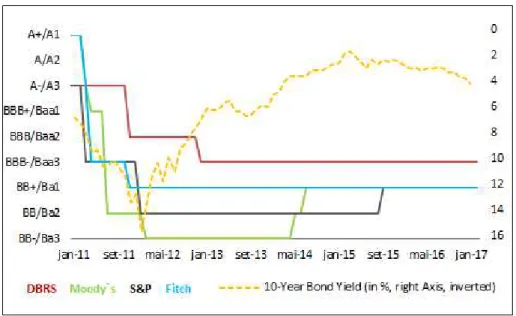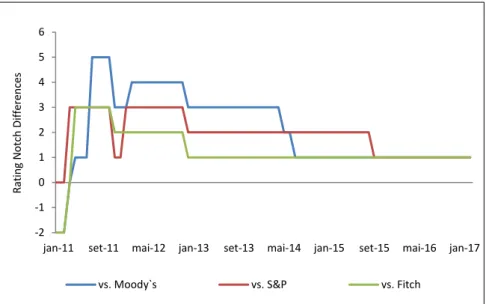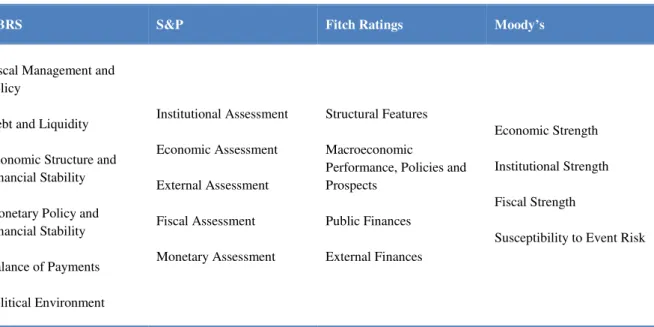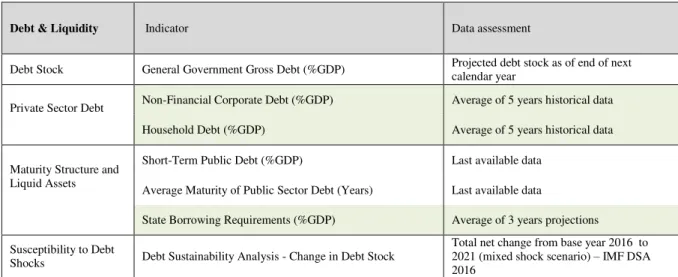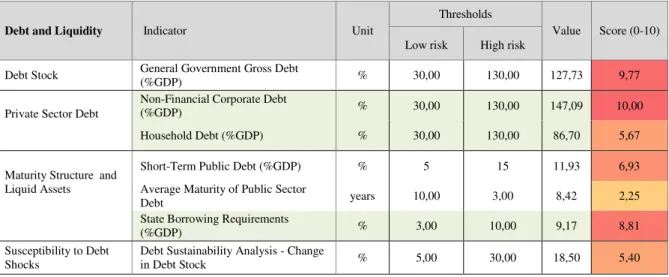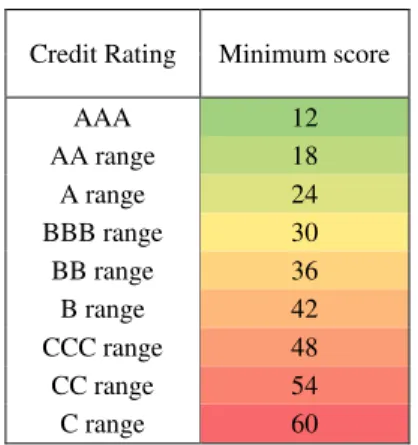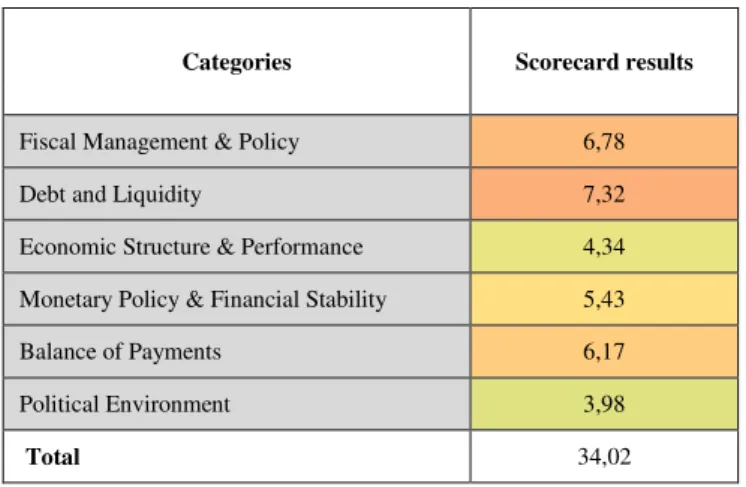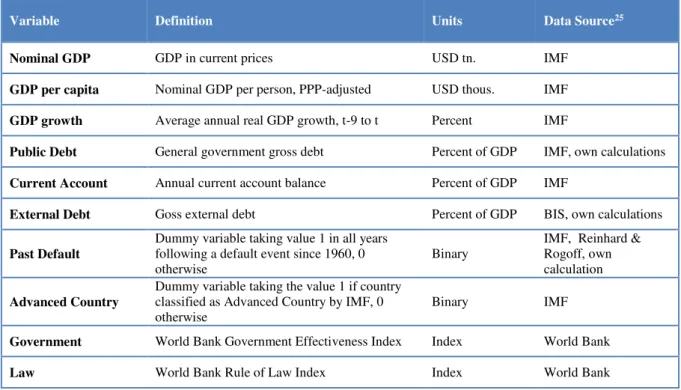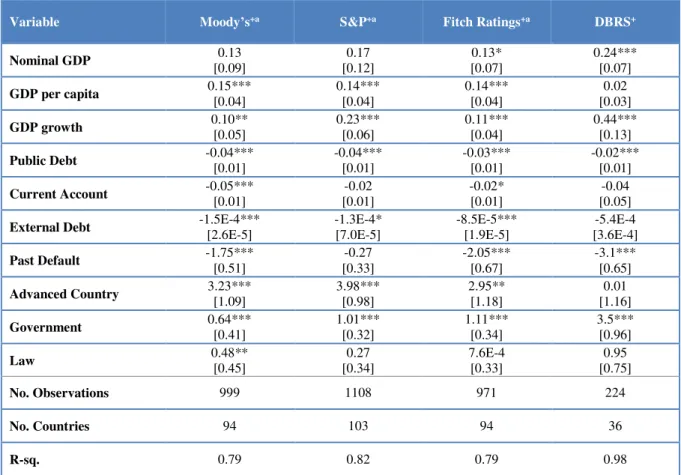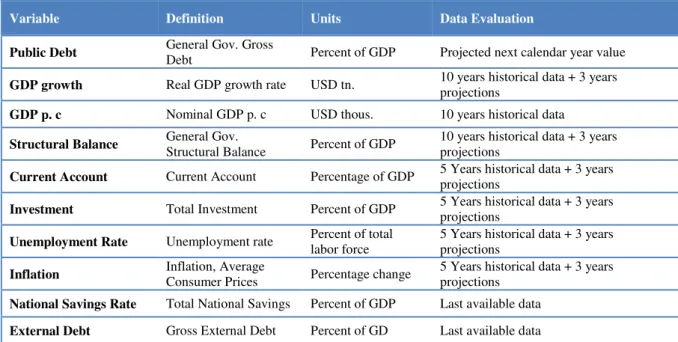1
Case Study: DBRS Sovereign Rating of Portugal
Analysis of Rating Methodology and Rating Decisions
Annika Luisa Hofmann, 812
Supervised by:
Prof. Miguel Ferreira
João Lampreia, Banco de Investimento Global
May 26, 2017
2
Abstract
This paper analyzes and assesses the DBRS sovereign credit rating methodology and its rating decisions on Portugal. A replicated rating model on Portugal allows to assess the DBRS rating methodology and to identify country-specific risk factors. An OLS regression compares rating effects of ten fundamental variables among S&P, Moody’s, Fitch Ratings and DBRS. Further, a rating scale model fractionally disentangles DBRS rating grades into their subjective and objective rating components. Both qualitative and empirical findings attest DBRS a comparably lenient rating behavior on Portugal –in comparison to other rating agencies as well as within the DBRS cross-country rating decisions.
Keywords: Sovereign Risk Model, Portugal, Subjective Rating Component
Acknowledgements: I offer my sinceregratitude to everyone who made this work possible.
To my academic advisor, Miguel Ferreira, who provided guidance and help at every point. To my institutional
advisor at Banco de Investimento Global, João Lampreia, who professionally and personally supported me along
the research process.
To my parents, Anita and Manfred Hofmann, who have been giving their unconditional support and love
throughout the past 25 years. Finally, to everyone who reviewed my work and gave their valuable and highly
3
CONTENT
1 Introduction ... 4
2 Literature Review ... 5
3 Qualitative Rating Analysis ... 6
3.1 Rating History on Portugal ... 6
3.2 Comparison with S&P, Moody’s and Fitch Ratings ... 8
4 Rating Model Replication ... 10
4.1 Structure and Composition ... 10
4.2 Replication Procedure ... 10
4.3 Results ... 13
5 Empirical Analysis ... 15
5.1 Risk factor effects: Cross-agency comparison ... 15
5.2 Subjective rating component analysis among DBRS cross-country ratings ... 17
6 Rating Outlook ... 21
7 Conclusion ... 22
8 References ... 23
9 Appendix ... 24
LIST OF FIGURES Figure 1: Historic sovereign ratings - Portugal ... 7
Figure 2: Rating differences – Portugal... 8
Figure 3: Subjective rating component - Panel results ... 20
Figure 4: Subjective rating component - Portugal ... 20
LIST OF TABLES Table 1: Core rating risk factors of the Big Three and DBRS ... 9
Table 2: Replicated model - Data evaluation ... 11
Table 3: Replicated model - Indicator scaling ... 12
Table 4: Replicated model – Weighting ... 12
Table 5: Sovereign scorecard map ... 13
Table 6: Replicated model - Scorecard results for Portugal ... 14
Table 7: Definition of variables – OLS regression ... 15
Table 8: OLS regression results ... 16
Table 9: Definition of variables - Rating scale model ... 19
4
1
Introduction
Sovereign credit ratings exercise strong economic and political influence on a country, particularly through its strong market signaling effects.1 Ratings take a significant role in determining a country’s (re-) financing conditions on the financial markets. Further, a potential credit downgrade can expose a country to limited institutional support - institutional investors are legally constrained from buying bonds with ratings below specific rating levels classified as “non-investment” status. Instancing, Portugal has been withdrawn the sovereign “investment grade” status by all renown rating agencies in the course of the financial crisis - primarily due to high public and private sector indebtedness, weak economic growth and a labile banking sector. The rather unknown Canadian rating agency DBRS on the contrary has been holding on to attesting Portugal “investment grade” status. The attestation of a sovereign “investment grade” by at least one major rating agency acts as the legal prerequisite for the government bond buying and refinancing programs of the ECB, and thereby ascribes the DBRS (future) sovereign risk assessment of Portugal decisive political and economic influence.2
This paper has been established in the course of a directed research internship at Banco de Investimento Global. The objective of this paper is to qualitatively and empiricaly analyze the DBRS sovereign credit rating methodology. Focus is specifically laid on its rating decisions on Portugal. The replication of the DBRS sovereign risk model of Portugal serves to identify and quantify key risk factors as well as give an assessment on technical specifications. The qualitative part assesses cross-agency historical ratings of Portugal and elaborates on general differences in rating methodologies among the major rating agencies. The empirical analysis of DBRS ratings closely follows the analysis approach by Vernazza, Nielsen and Gkionakis (2014). A panel OLS regression allows to compare rating effects of ten best-fitted fundamental variables among rating agencies. A rating scale model introduced by Studer and Winkelman (2016) fragments DBRS rating grades into their subjective and objective rating components.
This paper contributes to existent academic literature as well as adds value for active market participants. Current literature on sovereign ratings is mostly limited to the rating analysis of S&P, Moody’s and Fitch Ratings. The inclusion of DBRS rating decisions – applied at the case of Portugal – therefore allows to undertake a more comprehensive discussion on sovereign ratings. Further, an alternative statistical rating model for the purpose of sovereign risk analysis
1 Sovereign credit ratings are defined as long-term foreign-currency issuer ratings throughout this paper. 2 The ECB purchases governmental bonds through the Public Sector Purchase Programs (PSPP) since March
5
is being introduced and applied. Against the backdrop of DBRS’s significance with reference to the continuation of the bond purchase and financial sector refinancing programs, a better understanding and estimation of DBRS (future) rating decisions serves a crucial purpose equally for investors, institutions and politicians.
My key findings can be summarized as follow. The DBRS rating methodology lacks transparency. Susceptibility to debt shocks is significantly underrepresented. The replicated DBRS sovereign risk model of Portugal identifies the “political commitment to fiscal consolidation” as the striking justification for the ongoing issuance of investment-grading.3 The OLS regression identifies a country’s past default history, governmental effectiveness, rule of law and the long-term growth rate to have significantly greater effects under the DBRS rating framework than it is the case for S&P, Moody’s and Fitch Ratings. The rating scale model by Studer and Winkelmann attests DBRS to subjectively inflate its objective (fundamental) rating decisions of Portugal on average by one rating notch. Portugal’s subjective rating component has been diminishing over time, suggesting the rating grades to gradually approach their “fundamental” value. The cross-country subjective adjustment average is neutral. The DBRS rating decision on Portugal is, in the absence of changes in fundamental economic and political conditions, not expected to change in the medium-term.
The remainder of my paper proceeds as follows. In Section 2, I present and review relevant literature. Section 3 covers the qualitative rating analysis. Section 4 presents the DBRS rating model replication. Section 5 provides the empirical analysis of rating decisions on Portugal, both in comparison with the major rating agencies as well as within DBRS cross-country ratings. A rating outlook is presented in section 6. In section 7, I conclude and make suggestions for future rating research.
2
Literature Review
Bhatia and Lin (2022) provide a comprehensive introduction and qualitative evaluation of the sovereign credit rating methodologies of S&P, Moody’s and Fitch Ratings. Potential methodological improvements and rating failures across time are thereby examined. Literature on the determinants of sovereign risk is sizeable. Cantor and Packer (1996) identify per capita income, GDP growth, inflation, external debt, level of economic development and default history as S&P’s and Moody’s risk determinants under the application of an OLS regression.
6
Several papers since then have evaluated sovereign risk determinants, mostly using ordinary least squared regressions or ordered probit models.4 Afonso et al. (2011) extend the research by
distinguishing between short-term and long-term determinants employing linear and ordered response models.
Given the partially limited access and low transparency on agencies (sovereign) rating methodologies, the literature on rating model replications is scarce. D’Agostino and Lennkh (2016) reverse-engineer the Moody’s sovereign rating model to obtain sovereign ratings of 19 Euro member countries from 2005 to 2015.
This paper’s quantitative section closely follows Vernazza, Nielsen and Gkionakis’s research approach (2014). Ratings are decomposed into their subjective and objective rating components using OLS regressions. Significant subjective rating distortions for specific country groups – predominantly during the 2009-2011 sovereign debt crisis – are attested. Teker et al. (2013) have followed similar rating analysis through a factor based ordered probit model. Focus is laid on pre and post-crisis differences of Fitch Ratings’ decisions for various country groups. Moor, Luitel, Sercu and Vanpee (2017) apply an ordered logit model to investigate the subjective rating components and find that investment-graded countries are more prone to positive subjective adjustments. An EC regulatory framework was installed in 2009 with the purpose to increase transparency in the sovereign rating processes, ergo to reduce the degree of subjective judgement in final rating decisions.5 However, Amstad and Packer (2015)
empirically disprove methodological improvements.
3
Qualitative Rating Analysis
3.1 Rating History on Portugal
The Canadian rating agency DBRS started issuing sovereign credit ratings in 2000. Since then, DBRS has continuously been expanding its rating portfolio to a total of 36 countries.6
4 Afonso et al. (2007) identify GDP per capita, real GDP growth, government debt, government effectiveness,
external debt, external reserves and default history as determinants under the application of random effects ordered probit models.
5 EC Regulation No.1060/2009.
6 Argentina, Australia, Austria, Belgium, Brazil, Canada, Chile, China, Colombia, Cyprus, Denmark, Finland,
7
Portugal was first rated by the agency in November 2011. In comparison with the Big Three, DBRS follows a rather lenient rating behaviour on Portugal.7
Source: DBRS, S&P, Fitch Ratings, Moody’s, Bloomberg8
The Big Three have downgraded Portugal in the course of the European sovereign debt crisis 2009-2011 to “speculative” status. Moody’s firstly withdrew Portugal investment grading in July 2011, Fitch Ratings and S&P followed shortly in November 2011 respectively January 2012.9 The 10 Year yield curve of Portugal reacted correspondingly, reaching a record high of 15 percent in January 2012. DBRS on the contrary has continuously been holding on to attesting Portugal “investment grade” status. While its rating has also been downgraded in 2011 and 2012, the rating grades have steadily been above the “speculative grade” threshold. Since December 2012, DBRS attests Portugal the lowest possible sovereign investment grade “BBB“.
The comparably dovish rating behaviour of DBRS on Portugal cannot be generalized for all DBRS country rating decisions.10
7 S&P, Moody’s and Fitch Ratings are referred to as the “ Big Three” throughout this paper.
8 Rating decisions retrieved and collected from S&P, Moody’s, Fitch Rating’s and DBRS’s online databases. 9All rating equal or higher than “BBB-“/”Baa3” are defined as “investment grades”, any ratings below “BBB
-“/”Baa3” are classified as “speculative”.
10 Instancing, S&P has been issuing Greece the rating “B-“ since January 2016, while DBRS has been issuing the
lower “CCC+” grade since June 2016.
8
3.2 Comparison with S&P, Moody’s and Fitch Ratings
For the purpose to analyze the degree of rating disparities between the Big Three and DBRS, I convert all four rating agencies’ alphanumeric ratings into their numeric values following the transformation matrix in Appendix 1.
Figure 2: Rating differences – Portugal
Source: DBRS, S&P, Fitch Ratings, Moody’s11
Followed by S&P and Fitch Ratings, Moody’s shows the biggest discrepancies to DBRS’s rating decisions on Portugal, up to a maximum of five rating notches.12 Rating disparities have diminised over time though. Since September 2015 the rating decisions of the Big Three and DBRS differ by only one rating notch – the decisive rating threshold between “investment grade” and “speculative” status though.
All four rating agencies define sovereign default risk in a different manner. Moody’s ratings capture the expected loss, a function of the probability default and expected recovery rate after default.S&P ratings only reflect the probability of a default event; timing, severity and recovery values are subordinate. Fitch Ratings reflect the probability of default until default occurs, only accounting for expected recovery rates after the default event already incurred (Bhatia, 2002). DBRS ratings reflect the probability of default or the likelihood of full debt repayment in a timely manner.13
11 Rating decisions are retrieved and collected from the agencies’ online research portals.
12 In fall 2011, DBRS was issuing a stable investment grade of “A-“ while Moody’s already engaged in attesting
Portugal the speculative rating grade “Ba2” (respective “BB”).
13 DBRS. 2016. “Rating Sovereign Governments Methodology” manual.
-2 -1 0 1 2 3 4 5 6
jan-11 set-11 mai-12 jan-13 set-13 mai-14 jan-15 set-15 mai-16 jan-17
R
at
ing
N
o
tc
h
D
if
fe
re
nc
e
s
9
Table 1: Core rating risk factors of the Big Three and DBRS
DBRS S&P Fitch Ratings Moody’s
Fiscal Management and Policy
Debt and Liquidity
Economic Structure and Financial Stability
Monetary Policy and Financial Stability
Balance of Payments
Political Environment
Institutional Assessment
Economic Assessment
External Assessment
Fiscal Assessment
Monetary Assessment
Structural Features
Macroeconomic
Performance, Policies and Prospects
Public Finances
External Finances
Economic Strength
Institutional Strength
Fiscal Strength
Susceptibility to Event Risk
Source: DBRS, S&P, Fitch Ratings, Moody’s14
The Moody’s rating model consists of four core risk categories, each indicator’s performance is assessed on a range of very high plus (VH+) to very low minus (VL-). The rating procedure is rather cumbersome. Event scenarios under which the scorecard generated ratings are subjectively adjusted are outlined, the actual adjustment range however remains arbitrary. The S&P rating model is comprised of five key factors, each factor’s performance is assessed on a scale from one (weakest) to six (strongest). The final sovereign indicative rating is subject to max. +/- one subjective notch adjustment. The rating methodology is only partly-transparent, specifications on rating weightings are undisclosed. Fitch Ratings follows a multiple regression model accounting for 18 key risk variables. A forward-looking “Qualitative Overlay” framework allows the regression results to be adjusted for factors not captured by the model. Each one of the four rating pillars are subject to max. +/- two notch adjustments with an overall rating adjustment range of max. +/- three notches. The DBRS rating framework accounts for total six risk categories, assessed on a numeric scale of zero (low risk) to ten (high risk). Subjective rating adjustments are fully incomprehensible. Details on the DBRS rating methodology are introduced in the subsequent section 4.1.
10
4
Rating Model Replication
4.1 Structure and Composition
The DBRS rating framework is composed of two analytical pillars, a sovereign scorecard and a debt sustainability analysis. The latter has an effective impact of only five percent on the overall rating grade.
Within the sovereign scorecard, the risk factors (of both qualitative and quantitative nature) are grouped into six categories. Each risk category is comprised of minimum one primary element, in turn consisting of miminum one core indicator. Evaluated based on their historical and prospected performance, risk factors are individually scaled from 0=low risk to 10=high risk. Scores are individually weighted within and summed across the six categories and thus generate an overall scorecard result from 0=no default risk to 60=high default risk. The composite numeric score is lastly transformed into its respective alphanumeric rating grade.
DBRS claims that its rating decisions are more responsive to changes in fundamental characteristics rather than to changes in “cyclical economic conditions” – technical specifications are not disclosed.15 The transparency on the DBRS sovereign rating approach overall is considerably low – characteristic for the (sovereign) credit rating industry as a whole. Further, DBRS reserves for its final rating committee decisions to significantly deviate from the scorecard-generated result as “the relative importance of risk factors can vary” across countries. Tangible rules or adjustment ranges at this are fully undisclosed.
4.2 Replication Procedure
The replicated sovereign risk model of Portugal consists of total 43 qualitative and quantitative indicators. DBRS provides the data evaluation, threshold application and weighting of 16 risk indicators outlined in a hypothetical country rating model.16 I augment this model with additional 27 risk indicators collected from a risk indicator list further provided by DBRS.17 Those 27 indicators’ evaluation, thresholds and weightings follow – to the extent possible - the the data assessment, scoring and weighting of the 16 indicators provided with in the hypothetical country rating model. For transparency, the 27 indicators following self-evaluated data assessment and threshold establishments are color-marked green in my model. The 16
15 DBRS outlines fiscal responsibility, debt sustainability, economic diversification, price stability and the
stability of the political system as exemplary fundamental country factors.
11
indicators with fully disclosed data assessment and threshold establishment are non color-marked.
For simplicity, subsequent rating steps a) - e) are illustrated at hand of the risk category
Debt and Liquidity.18 The full list of all 43 indicators’ data assessment, performance evaluation
and weighing is provided in the Appendix.
a) Data Evaluation
Each risk factor is individually evaluated, predominantely by taking the average of a combination of historical and forecasted datapoints. Data is mainly collected from large international institutions such as IMF, Worldbank and OECD. The individual data evaluation of all 43 indicators is provided in Appendix 3.
Table 2: Replicated model - Data evaluation
Debt & Liquidity Indicator Data assessment
Debt Stock General Government Gross Debt (%GDP) Projected debt stock as of end of next calendar year
Private Sector Debt
Non-Financial Corporate Debt (%GDP) Average of 5 years historical data Household Debt (%GDP) Average of 5 years historical data Maturity Structure and
Liquid Assets
Short-Term Public Debt (%GDP) Last available data Average Maturity of Public Sector Debt (Years) Last available data
State Borrowing Requirements (%GDP) Average of 3 years projections Susceptibility to Debt
Shocks Debt Sustainability Analysis - Change in Debt Stock
Total net change from base year 2016 to 2021 (mixed shock scenario) – IMF DSA 2016
b) Indicator Scaling
Evaluated based on their historical and prospected future performance, each factor is scaled from 0=low risk to 10=high risk under the application of individual - and mostly arbitrarily chosen – thresholds. If not given guidance by similar indicators outlined in the hypothetical country model, indicator values of worse and better performing OECD countries are used as a
18 To shortly exhibit the general model structure at this example, Debt and Liquidity represents one of the six risk
12
strong guide for the threshold establishment of the additional 27 indicators.19 The indicator
scaling for all factors is provided in Appendix 4.
Table 3: Replicated model - Indicator scaling
Debt and Liquidity Indicator Unit
Thresholds
Value Score (0-10) Low risk High risk
Debt Stock General Government Gross Debt
(%GDP) % 30,00 130,00 127,73 9,77 Private Sector Debt
Non-Financial Corporate Debt
(%GDP) % 30,00 130,00 147,09 10,00 Household Debt (%GDP) % 30,00 130,00 86,70 5,67 Maturity Structure and
Liquid Assets
Short-Term Public Debt (%GDP) % 5 15 11,93 6,93 Average Maturity of Public Sector
Debt years 10,00 3,00 8,42 2,25 State Borrowing Requirements
(%GDP) % 3,00 10,00 9,17 8,81
Susceptibility to Debt Shocks
Debt Sustainability Analysis - Change
in Debt Stock % 5,00 30,00 18,50 5,40
c) Weightings
Each primary element’s score represents the average of its core elements’ scores, weightings within a category can vary. Each one of the six categories is equally weighted within the rating framework. The weighting for my augmented model is built on the weighting structure provided for the DBRS hypothetical country model.20 The weighting structure of the entire replicated model is outlined in Appendix 5.
Table 4: Replicated model – Weighting
Debt and Liquidity Indicator Individual Score
Averaged within Primary Element Weighting within Category Individual overall rating weight Debt stock General Government Gross Debt
(%GDP) 9,77 9,77 30% 5,00%
Private Sector Debt
Non-Financial Corporate Debt
(%GDP) 10,00
7,83 20%
3,33%
Household Debt (%GDP) 5,67 3,33%
Maturity Structure & Liquid Assets
Short-Term Public Debt (%GDP) 6,93
6,00 20%
3,33% Average Maturity of Public Sector
Debt (Years) 2,25 3,33%
State Borrowing Requirements
(%GDP) 8,81 3,33%
Susceptibility to Debt Shocks
Debt Susceptibility Analysis -
Change in Debt Stock 5,40 5,40 30% 5,00%
19 Instancing, the threshold establishment for income inequality takes the Gini coefficient of Norway (0.25) and
Brazil (0.5) as its low and high risk benchmarks.
13
d) Scorecard Mapping
Lastly, the indicative scorecard result is transformed into its respective alphanumeric rating grade following a sovereign scorecard map. In the case of Portugal, the current sovereign credit rating of “BBB-“ corresponds to a numeric value of roughly 34.
Table 5: Sovereign scorecard map
Credit Rating Minimum score
AAA 12
AA range 18
A range 24
BBB range 30
BB range 36
B range 42
CCC range 48
CC range 54
C range 60
Source: DBRS21
e) Foreign currency vs. local currency sovereign rating
As it is the case for all advanced country, the strong international market integration of Portugal makes a differentiation between foreign currency and local currency sovereign rating redundant.
4.3
Results
My replicated model generates a numeric scorecard result falling within the lower “BBB range” as corresponding to Table 5. The replicated sovereign scorecard identifies Fiscal Management
& Policy and Debt & Liquidity as the highest risk categories. Positive momentum emanates
from Political Environment, the degree of “political commitment to fiscal consolidation”
thereby plays a significant role.22 Strong positive effects emanate from individual risk factors
such as the Rate of Inflation, Current Account Balance and Capital Account Balance.23
Negative momentum originates from the individual risk factors Interest Payment (% Revenue),
Public and Non-Financial Corporate Debt, State Borrowing Requirements, Total Domestic
14
Savings Rate, Loan to Deposit Ratio as well as Gross International Investment Position and Net
External Debt.
Table 6: Replicated model - Scorecard results for Portugal
Categories Scorecard results
Fiscal Management & Policy 6,78 Debt and Liquidity 7,32 Economic Structure & Performance 4,34 Monetary Policy & Financial Stability 5,43 Balance of Payments 6,17 Political Environment 3,98
Total 34,02
Political Environment is the most qualitatively captured category of all. The category consists
of two purely qualitative primary elements: a) Institutional environment is assessed based on World Bank Indexes, while b) Political commitment to address economic challenges and
service debt is based fully on the subjective assessment of the DBRS rating committee. Latter
holds 50% of the category’s rating scale and 8.33% on the final rating scale. DBRS provides a qualitative assessment on Political Environment in its rating reports, the justification and transparency of this category is however not satisfactory. As already stated, this paper identifies the “political commitment to fiscal consolidation” as the striking justification for ongoing investment grading of Portugal. The currently most decisive rating aspect therefore underlies a fully subjective assessment, making potential crucial rating alterations in large part incomprehensible for external parties.
Although presented as a major rating pillar, the debt sustainability analysis has a rather negligible effect on DBRS rating decision. Given Portugal’s comparably high public debt stock, its susceptibility to (external) shocks – along with its harmful risk channels – should be given a stronger significance within the model.
Given its individual rating weights, the model output is most sensitive to changes in following variables: Net International Investment Position (4.17%), Net External Liabilities
(4.17%), General Government Gross Debt (5%), Debt Susceptibility Analysis (5%), and
Commitment to address economic challenges and service debt (8.33%).
15
5
Empirical Analysis
5.1 Risk factor effects: Cross-agency comparison
For the empirical analysis of rating differences among S&P, Moody’s, Fitch Ratings and DBRS, I compare the cross-agency rating effects of ten fundamental economic variables. I thereby closely follow the OLS regression approach conducted by Vernazza, Nielsen and Gkionakis (2014), who already modeled rating decisions of Moody’s, S&P and Fitch Ratings on ten best-fitting risk variables. By replicating their approach to DBRS rating grades, parameter estimates can directly be compared across all four rating agencies.
A panel data set of total 224 end-of-year DBRS rating decisions of 36 different countries 𝑖 from November 2000 until March 2017 are OLS-regressed on the fundamental variables vector 𝜒𝑖𝑡 and a macro time effect 𝑍𝑡.24
𝑟𝑎𝑡𝑖𝑛𝑔𝑖𝑡 = 𝛽′𝜒𝑖𝑡+ 𝑍𝑡+ 𝜀𝑖𝑡 (1)
Alphanumeric rating variables are again converted into numeric values following the conversion table in Appendix 1. The ten fundamental economic variables are chosen based on goodness-of-fit tests conducted by Vernazza, Nielsen and Gkionakis.
Table 7: Definition of variables – OLS regression
Variable Definition Units Data Source25
Nominal GDP GDP in current prices USD tn. IMF
GDP per capita Nominal GDP per person, PPP-adjusted USD thous. IMF
GDP growth Average annual real GDP growth, t-9 to t Percent IMF
Public Debt General government gross debt Percent of GDP IMF, own calculations
Current Account Annual current account balance Percent of GDP IMF
External Debt Goss external debt Percent of GDP BIS, own calculations
Past Default
Dummy variable taking value 1 in all years following a default event since 1960, 0 otherwise
Binary
IMF, Reinhard & Rogoff, own calculation
Advanced Country
Dummy variable taking the value 1 if country classified as Advanced Country by IMF, 0 otherwise
Binary IMF
Government World Bank Government Effectiveness Index Index World Bank
Law World Bank Rule of Law Index Index World Bank
16
Table 8: OLS regression results
Variable Moody’s+a S&P+a Fitch Ratings+a DBRS+
Nominal GDP 0.13
[0.09] 0.17 [0.12] 0.13* [0.07] 0.24*** [0.07]
GDP per capita 0.15***
[0.04] 0.14*** [0.04] 0.14*** [0.04] 0.02 [0.03]
GDP growth 0.10**
[0.05] 0.23*** [0.06] 0.11*** [0.04] 0.44*** [0.13]
Public Debt -0.04***
[0.01] -0.04*** [0.01] -0.03*** [0.01] -0.02*** [0.01]
Current Account -0.05***
[0.01] -0.02 [0.01] -0.02* [0.01] -0.04 [0.05]
External Debt -1.5E-4***
[2.6E-5] -1.3E-4* [7.0E-5] -8.5E-5*** [1.9E-5] -5.4E-4 [3.6E-4]
Past Default -1.75***
[0.51] -0.27 [0.33] -2.05*** [0.67] -3.1*** [0.65]
Advanced Country 3.23***
[1.09] 3.98*** [0.98] 2.95** [1.18] 0.01 [1.16]
Government 0.64***
[0.41] 1.01*** [0.32] 1.11*** [0.34] 3.5*** [0.96]
Law 0.48**
[0.45] 0.27 [0.34] 7.6E-4 [0.33] 0.95 [0.75]
No. Observations 999 1108 971 224
No. Countries 94 103 94 36
R-sq. 0.79 0.82 0.79 0.98
+ Significance level: * 10%; ** 5%; ***1%
a Regression results for S&P, Moody’s and Fitch Ratings are taken from Vernazza, Nielsen and Gkionakis (2016),
DBRS regression results are depicted in Appendix 2.
A number of DBRS parameters are statistically insignificant. This might be due to the significantly smaller number of available DBRS rating observations or due to the inappropriateness of the best-fitted explanatory variables under the DBRS rating framework.26
The regression model predicts Public Debt, Current Account and External Debt to similarily affect rating decisions across all agencies. GDP per capita and the dummy variable Advanced
Country appear to play a comparably smaller role under the DBRS rating framework, the
estimators are also statistically insignificant. Past Default history, long-term GDP growth as well as the Government and Law index are expected to have significant larger effects under the DBRS rating framework than it is the case for S&P, Moody’s or Fitch Ratings.27
17
5.2 Subjective rating component analysis among DBRS cross-country ratings
In the paper by Vernazza, Nielsen and Gkionakis (2014) rating grades are further broken down into their subjective and objective rating components. The fitted values of their OLS regressions are thereby defined as the objective component - ratings solely based on the ten fundamental variables. The difference between the observed and fitted values (residuals) are interpreted as the subjective rating adjustment.28
As already assessed in this paper, DBRS fails to deliver tangible rules on its subjective rating adjustments, thereby leaving a potentially significant component of the DBRS rating decision on Portugal incomprehensible. The motivation to further analyze the significance of the subjective rating components for the rating decisions on Portugal – in specific its comparison within the DBRS cross-country ratings - is therefore considerably high.
Cross-panel DBRS rating decisions are therefore fragmented into their subjective and objective rating component following the Vernaza, Nielsen and Gkionakis analysis approach. The model itself is however significantly altered in this paper.
(a)
The analysis of rating dependent variables under the application of an OLS-regression has significant shortcomings. The dependent variable is unbounded, categories are assummed to be equi-distant and marginal effects to be constant. Ratings are however bounded within the rating scale from default status “D” to highest investment grading “AAA”. Changes in risk variables along the rating scale can depict varying marginal effects - in specific when reaching the uppper and lower rating grade limits. An OLS regression is therefore only suitable to a limited extent. Ordered probit models treat variables as ordinal, and thereby cannot serve the purpose to fractionally decompose DBRS rating grades. Further, the ordered probit model’s interpretation becomes laborous with an increasing number of categories – a minimum of 24 ordinal categories in the sovereign risk rating case.
I therefore follow an alterative rating scale model developed by Studer and Winkelmann (2016), applying a Bernoulli quasi-maximum likelihood estimation (QMLE).29 The random
component 𝑦𝑖𝑡 is assumed to follow a Bernoulli distribution. The expected value of 𝑦𝑖𝑡 (mean reponse) depends on the linear predictor of the explanatory variables through a probit function
28 Vernazza, Nielsen and Gkionakis follow a rather “maximalist definition” by lumping the entire residual into
the subjective part (Moor, Luitel, Sercu and Vanpee, 2017).
18
𝐺(𝑥).30 The model allows me to obtain fitted fractional values, to comply with rating boundaries and to allow for non-constant marginal effects.
Following the Bernoulli distribution, the limited dependent variable 𝑦𝑖𝑡 has to lie within the range of [0, 𝑦𝑚𝑎𝑥] with a probability of 1 and 𝑦𝑚𝑎𝑥 as the rating grade “AAA”. The numerically converted rating variables (again following the rating conversion table in Appendix 1) threrefore need to be transformed into their respective fractional values. The lowest rating bound “D” corresponds to a numeric value of 2. The dependent fractional variable 𝑦𝑖 therefore has to be computed as follow
𝑦𝑖𝑡 = (y𝑖𝑡− 2)/𝑦𝑚𝑎𝑥 with 𝑦𝑚𝑎𝑥 = 22 (2)
with the scaled probit model version of
𝐺(𝑥𝑖𝑡′𝛽 + 𝛾𝑍𝑡+ 𝜀𝑖𝑡) = 𝑦𝑚𝑎𝑥𝜙(𝑥𝑖𝑡′𝛽 + 𝛾𝑍𝑡+ 𝜀𝑖𝑡) (3)
and the Bernoulli quasi-likelihood function for 𝑛 observations of
𝐿 = ∏𝑛𝑖=1 (𝐺(𝑥𝑖𝑡 ′𝛽)
𝑦𝑚𝑎𝑥 ) 𝑦𝑖𝑡 𝑦𝑚𝑎𝑥
(𝑦𝑚𝑎𝑥−𝐺(𝑥𝑖𝑡′𝛽)
𝑦𝑚𝑎𝑥 )
1−𝑦𝑖𝑡 𝑦𝑚𝑎𝑥
. (4)
Marginal effects diminish as the model approaches its upper and lower bounds, ultimately reaching zero in the limit (𝑙).
𝜕 𝐸(𝑦𝑖𝑡|𝑥𝑖𝑡)
𝜕𝑥𝑖𝑙 = 𝑦𝑚𝑎𝑥𝜙(𝑥𝑖𝑡 ′𝛽)𝛽
𝑙 (5)
Robust standard errors are used, the macro-time effect also remains in place.31
(b)
The ten best-fitting regressors under the Vernazza, Nielsen and Gkionakis OLS model are not fully satisfactory and appropriate for my QMLE model. I replace PastDefault, Advanced
Country, Law and Government with the new variables Investment, Unemployment Rate,
National Savings Rate and Inflation.32 Further, all variables are evaluated following the DBRS
30 The model can also be run with a logistic link function, coefficients are however slightly more significant
under probit.
31 As the dependent variable is not binary but a rating variable, Studer and Winkelmann (2016) apply robust
standard errors.
32 Indicators are either insignificant under the new model or not accounted for under the DBRS rating
19
rating methodology.33 Data is collected from the IMF World Economic Outlook 2017.34 Again,
the model is based on a panel data set of 224 observations, consisting of DBRS end-of-year rating decisions of total 36 different countries 𝑖 from November 2000 until March 2017.
Table 9: Definition of variables - Rating scale model
Regression results are presented in Appendix 2. The coefficients reported are asymptotically equivalent to maximum likelihood estimators. All variables are statistically strongly significant. The estimated effects and standard errors need to be retransformed into their actual values by multiplying by 𝑦𝑚𝑎𝑥. Parameter signs are as anticipated, with the exception of GDP Growth. Further coefficients interpretation is however not objective of this empirical analysis.
Following Vernazza, Nielsen and Gkionakis, the difference between observed and fitted ratings represent the subjective rating component. The fitted fractional rating grades 𝑦𝑖𝑡∗ are obtained as follow.
𝑦𝑖𝑡∗ = y𝑖𝑡𝑓𝑖𝑡𝑡𝑒𝑑∗ 𝑦𝑚𝑎𝑥+ 2 (6)
The model’s goodness-of fit is tested under the criterion of deviance as well as the Akaike (AIC) and Bayesian (BIC) information criteria.
33 Accounting for the DBRS longer-term rating approach (e.g. taking the average of 10/5 Y historic data + 3 Y
forecasted data points), in individual cases constrained by data availability (e.g. External Debt). National Savings Rateis accounted for as “Last available data” and Public Debt as “Projected next calendar year value” value under the DBRS rating framework.
34 With the exception for External Debt, collected from the Bank of International Settlement (SDDS Databank).
Variable Definition Units Data Evaluation
Public Debt General Gov. Gross
Debt Percent of GDP Projected next calendar year value
GDP growth Real GDP growth rate USD tn. 10 years historical data + 3 years
projections
GDP p. c Nominal GDP p. c USD thous. 10 years historical data
Structural Balance General Gov.
Structural Balance Percent of GDP
10 years historical data + 3 years projections
Current Account Current Account Percentage of GDP 5 Years historical data + 3 years projections
Investment Total Investment Percent of GDP 5 Years historical data + 3 years projections
Unemployment Rate Unemployment rate Percent of total labor force
5 Years historical data + 3 years projections
Inflation Inflation, Average
Consumer Prices Percentage change
5 Years historical data + 3 years projections
National Savings Rate Total National Savings Percent of GDP Last available data
20
The model attests DBRS a comparably “dovish” rating behavior on Portugal, on average inflating the objective rating by one subjective notch adjustment (+1.01). The subjective rating component among all DBRS cross-country ratings is neutral (-2.5E-5).35 A generally more lenient rating characteristic of DBRS across all countries can therefore not be testified.
When depicting the subjective rating component of Portugal across time, the extent of subjective rating adjustment appears to diminish since reaching its peak in 2013. The model therefore suggests DBRS rating decisions on Portugal to gradually approach their fundamental, quantifiable rating values.36
Figure 4: Subjective rating component - Portugal
35 Interestingly, the negative outliers depicted in Figure 3 are DBRS rating decisions on Cyprus in the years 2013
and 2014, and Argentina in 2015.
36 The numeric rating value of 15 corresponds to the alphanumeric rating grade of “BBB-“.
-12 -10 -8 -6 -4 -2 0 2 4 6
0 4 8 12 16 20 24
S ub je ct iv e N o tc h A dju st m e nt Observed Ratings Portugal
Figure 3: Subjective rating component - Panel results
0 0,5 1 1,5 2 2,5 3 12 13 14 15 16 17 18
2010 2011 2012 2013 2014 2015 2016
S ub je ct iv e N o tc h A dju st m e nt N um e ri c R at ing Val ue s
21
6
Rating Outlook
S&P and Moody’s have reaffirmed their “BB+” respectively “Ba1” ratings earlier this year, and both outlooks remain stable. In line with the predictions provided based on preliminary results of my models, DBRS has kept its rating decision on April 21, 2017 unchanged to “BBB-“ with
a stable outlook. Fundamental economic and political conditions have not changed substantially since its last rating report in October 2016. The high indebtedness of both the private (non-financial corporate debt level of 117 percent of GDP) and public sector (gross government debt of 128 percent GDP) remain the limiting factors. External debt (220 percent of GPD) is one of the highest worldwide. Commitment to fiscal consolidation is assessed to still be strong. Budget deficit improvements (2 percent of GDP in 2016) will likely allow Portugal to leave the Excessive Deficit Procedure early. Large parts of fiscal improvements are however due to one-off measures (e.g. the PERES program) and significant cuts in public investment.37 Receding banking sector risks (due to e.g. the finalized sale of Novo Banco and the recapitalization of Caixa Geral de Depositós and Banco Comercial Português) give a positive momentum, are however not expected to change the rating grade. The share of non-performing loans remains alerting (12% of total loans). The ECB has been gradually reducing its monthly bond buying purchase volumes, expected to be tapering out by the end of this year.38 Pressure on
governmental bond yields is (ceteris paribus) anticipated.
Against the backdrop of the outlined economic situation of Portugal as well as the potential rating adjustment scenarios given by DBRS itself, I expect the DBRS rating decision on Portugal to remain unchanged for this calendar year.
Table 10: Scenarios of Future Rating Adjustments
Source: DBRS39
37 Special Program for Reduction of Debt to the State Department (PERES): incentive-creating tax repayment
scheme for households and corporations. The program is estimated of having generated 300 Mio. EUR one-off state revenues for the 2016 state budget.
38 Constrained by the capital key and the ECB rule to hold max. one third of a country’s total outstanding debt as
well as the PSPP program’s expected termination by the end of this year.
39 DBRS Rating Report of Portugal from 21 October 2016 and 21 April 2017.
Downward Upward
Deterioration in public debt dynamics Sustainable improvement in public finances
Contraction of fiscal
22
7
Conclusion
In this paper, I provide a comprehensive analysis and assessment of the DBRS sovereign rating methodology. Both my qualitative and empirical analysis attest DBRS a comparably dovish rating behavior on Portugal, not only in comparison with the Big Three’s rating decisions but also within the DBRS cross-country ratings. The replicated model identifies Fiscal
Management & Policy and Debt & Liquidity as the highest risk categories. A positive
momemtum emanates from the risk category Political Environment. The “political commitment
to fiscal consolidation” is identified as the striking qualitative justification of ongoing investment grading of Portugal. The transparency on the DBRS rating methodology is significantly low. On average, the Portuguese objective rating is subjectively inflated by one rating notch.
From a technical point of view, it could be interesting to study further the rating scale model introduced by Studer and Wineklmann (2016) and to compare its results obtained in this paper employing alternative rating analysis approaches.40 Additionally, one could elaborate further what events or indicator changes underlie the extraordinary positive subjective rating adjustment in 2013. Further, one could extend the subjective rating component analysis to other countries. For example, Cyprus, Argentina and Greece would be of great interest to analyze, in specific its component developments during the sovereign debt crisis.
Just like any other model, the DBRS rating model has its shortcomings. This paper finds significant subjective rating adjustment in the case of Portugal, which does not necessarily indicate that the DBRS rating model is flawed and imprecise per se. The incorporation of (qualitative) country-specific advantages and disadvantages can result in more appropriate and sophisticated final rating decisions than to purely follow quantifiable output. Rating agencies should however - particularly DBRS - be more transparent in their rating assessment. D’Agostino and Lennkh (2016) recommend the publication of two distinct credit ratings: a) a purely quantitatively derived grade as well as b) a final rating including the rating agency’s subjective adjustment. Market participants could then assess and evaluate the appropriateness of the subjective rating adjustment by themselves.
23
8
References
Afonso et al. 2007. “What hides behind sovereign debt ratings.” ECB Working Paper Series 711.
Afonso et al. 2011. “Short and long-run determinants of sovereign debt credit ratings.” International Journal of Finance & Economics.
Amstad and Packer. 2015. “Sovereign ratings of advanced and emerging economies after the crisis. BIS
Quarterly Review December.
Bhatia.2002.”Sovereign Credit Ratings Methodology: An Evaluation.” IMF Working Paper WP/02/170.
Cantor and Packer.1996.”Determinants and Impact of Sovereign Creit Ratings.” Federal Reserve Bank of New York Economic Policy Review.
D’Agostino and Lennkh. 2016. ”Euro Area Sovereign Ratings: An Analysis of Fundamental Criteria and Subjective Judgement.” ESM Working Paper Series. No. 14.
DBRS. 2016. “Rating Sovereign Governments Methodology.” http://www.dbrs.com/research/300639/rating-sovereign-governments.pdf.
Fitch Ratings. 2016. “Sovereign Rating Criteria.”http://fitchratings.com
Hilbe Joseph M.. 2014. ”Generalized Linear Models.” Arizona State University.
McCullagh and Nelder. 1989. “Generalized Linear Models”.2d ed. London: Chapman & Hall.
Moody’s. 2016. “Rating Methodology: Sovereign Bond Ratings.”
https://www.moodys.com/researchdocumentcontentpage.aspx?docid=PBC_1044859.
Moor, Luitel, Sercu and Vanpee. 2017. “Subjectivity in sovereign credit ratings.” Faculty of Economics and Business, KU Leuven.
Standard & Poor’s. 2014. “Sovereign Rating Methodology.”
https://www.standardandpoors.com/en_US/web/guest/article/-/view/type/HTML/id/1813072.
Teker, Pala and Kent. 2013. “Determinants of Sovereign Ratings Factor Based Ordered Probit Models for Panel Data Analysis Modelling Framework.”International Journal of Economics and Financial Issues, Volume 3.
Vernazza, Nielsen and Gkionakis. 2014. “The Damaging Bias of Sovereign Ratings.”Unicredit Globals Themes Series. No.21.
Stata Users Guide. 2015. Version 14. College Station: Stata Press.
Studer and Winkelmann. 2016. “Economic Analysis of Ratings – with an Application to Health and Wellbeing.” University of Zurich.
24
9
Appendix
Appendix 1: Rating conversion table
Fitch Ratings Moody’s S&P DBRS Numerical Scale
AAA Aaa AAA AAA 24
AA+ Aa1 AA+ AA+ 23
AA Aa2 AA AA 22
AA- Aa3 AA- AA- 21
A+ A1 A+ A+ 20
A A2 A A 19
A- A3 A- A- 18
BBB+ Baa1 BBB+ BBB+ 17
BBB Baa2 BBB BBB 16
BBB- Baa3 BBB- BBB- 15
BB+ Ba1 BB+ BB+ 14
BB Ba2 BB BB 13
BB- Ba3 BB- BB- 12
B+ B1 B+ B+ 11
B B2 B B 10
B- B3 B- B- 9
CCC+ Caa1 CCC+ CCC+ 8
CCC Caa2 CCC CCC 7
CCC- Caa3 CCC- CCC- 6
CC Ca CC CC 5
C C C C 4
DDD SD SD 3
DD D D 2
D 1
Appendix 2: Regression Output
OLS Regression+
(ordinal dependent rating variable)
QMLE Regression+*
(fractional dependent rating variable)
Nominal GDP 0.241***
(0.069)
GDP per capita 0.017
(0.028)
GDP growth 0.442***
(0.125)
Public Debt -0.021***
(0.006)
Current Account -0.041
(0.051)
External Debt (OLS as well as QMLE) -0.001 -0.001***
(0.000) (0.000)
Past Default -3.134***
(0.645) Advanced Country 0.010
(1.158) Government Effectiveness Index 3.483***
(0.955) Rule of Law Index 0.948
(0.753)
Public Debt (QMLE) -0.009***
(0.001)
GDP Growth (QMLE) -0.131***
(0.039)
National Savings Rate (QMLE) -0.066**
(0.027)
Current Account (QMLE) 0.105***
(0.021)
GDP per capita (QMLE) 0.052***
(0.006)
25
(0.021)
Unemployment Rate (QMLE) -0.039***
(0.008)
Inflation Rate (QMLE) -0.082***
(0.017)
Investment Rate (QMLE) 0.128***
(0.027)
Observations 224 224
Adjusted 𝑅2 0.984
Deviance 13.55
+Significance level: * 10%; ** 5%; ***1%
*The QMLE Regression uses different data assessment than the OLS regression in the attempt to replicate the DBRS rating methodology as close as possible (Table 9).
Appendix 3: Replicated Model - Data Assessment
Primary Element Indicator Methodology
Fiscal Management & Policy
Overall Fiscal Performance Overall Fiscal Balance (%GDP) Average of 10 years historical data + 3 years
projection
Structural Fiscal Balance (%GDP) Average of 10 years historical data + 3 years
projection
Primary Fiscal Balance (%GDP) Average of 10 years historical data + 3 years
projection
Interest Payments (%Revenues) Last available data
Gov. Policy Management & Budget Control Government Policymaking Transparency Global Competitiveness Index - Last available data
Quality of Public Spending Global Competitiveness Index - Last available data
Public Investment (%GDP) Last available data
Debt and Liquidity
Debt Stock General Government Gross Debt (%GDP) Projected debt stock as of end of next calendar year
Private Sector Debt Non-Financial Corporate Debt (%GDP) Average of 5 years historical data
Household Debt (%GDP) Average of 5 years historical data
Maturity Structure & Liquid Assets Short-Term Public Debt (%GDP) Last available data
Average Maturity of Public Sector Debt (Years) Last available data
State Borrowing Requirements (%GDP) Average of 3 years projections
Susceptibility to Debt Shocks Debt Sustainability Analysis - Change in Debt Stock Total net change from base year 2016 to 2021 (mixed shock scenario) - IMF DSA 2016
Economic Structure & Performance
Econ. Growth & Productivity Real GDP p.c. Growth (%) Average of 10 years historical data + 3 years
projections
GDP p.c. (Thous. USD) Average of 10 years historical data
Human Development Index UNDP Index - Last available data
Econ. Resilience & Flexibility Output Volatility (%)
Standard deviation of real GDP growth rate measured over 20 years of historical data + projected next 3 years
Unemployment Rate (%) Average of 5 years historical data + 3 years
projection
Doing Business Ranking World Bank World Bank Index - Last available data
Change in Real Unit Labor Cost (%) Average of 5 years historical data
Private Sector Investment & Savings Households Investment Rate Average of 5 years historical data
Non-Financial Corporate Investment Rate Average of 5 years historical data
Demographics Population Growth Average of 10 years historical data + 3 years
projection
Income Distribution Gini-Coefficient Last available data
Monetary Policy & Financial Stability
Policy Credibility Rate of Inflation (%) Average of 5 years historical data + 3 years
projections
Total Domestic Savings (%GDP) Last available data
Change in 10Y PGB Yields during Economic
Slowdown*
Average annual change over 17 years historical data (Bps)
Financial Risk Gross Non-Performing Loans (%Total Loans) Last available data
Loan to Deposit Ratio Last available data
Tier 1 Capital Ratio Last available data
Regulation Securities Exchanges Global Competitiveness Index - Last available data
Balance of Payments
External Imbalance Current Account Balance (%GDP) Average of 5 years historical data + 3 years
projections
Capital Account Balance (%GDP) Average of 5 years historical data + 3 years
projections
Foreign Direct Investment (%GDP) Average of 5 years historical data
26
Net Investment Position & Foreign Reserves
Liquidity Net International Investment Position (%GDP) Average of 5 years historical data
Gross External Liabilities (%GDP) Average of 5 years historical data
Political Environment
Institutional Environment Voice and Accountability (Index) World Bank Governance Indicators - Last availble
data
Rule of Law (Index) World Bank Governance Indicators - Last availble
data
Government Effectiveness (Index) Global Competitiveness Index - Last available data
Judicial Independence (Index) Global Competitiveness Index - Last available data
Commitment to address economic challenges and service debt
Government capacity and willingness to act in response to economic and financial challenges
subjective assessment based on thought exchange with institutional representatives and bank-intern discussions
*Economic slowdown defined as: real annual GDP growth ≤ 0.5 of standard deviation of historical real GDP growth (17 years)
Appendix 4: Replicated Model - Indicator Scaling
Primary Element Indicator Unit Threshold Value Score (0-10)
Low risk High risk
Fiscal Management & Policy
Overall Fiscal Performance Overall Fiscal Balance (%GDP) % 0,00 -8,00 -5,25 6,56
Structural Fiscal Balance (%GDP) % 0,00 -6,00 -3,64 6,07
Primary Fiscal Balance (%GDP) % 0,00 -3,00 -1,53 5,08
Interest Payment (%Revenue) % 5,00 8,00 10,29 10,00
Gov. Policy Management & Budget
Control Government Policymaking Transparency Index 7,00 1,00 3,90 5,17
Quality of Public Spending Index 7,00 1,00 2,80 7,00
Public Investment (%GDP) % 10,00 0,00 2,27 7,73
Debt and Liquidity
Debt Stock General Government Gross Debt (%GDP) % 30 130 127,73 9,77
Private Sector Debt Non-Financial Corporate Debt (%GDP) % 30,00 130,00 147,09 10,00
Household Debt (%GDP) % 30,00 130,00 86,70 5,67
Maturity Structure & Liquid Assets Short-Term Public Debt (%GDP) % 5 15 11,93 6,93
Average Maturity of Public Sector Debt Years 10,00 3,00 8,42 2,25
State Borrowing Requirements (%GDP) % 3,00 10,00 9,17 8,81
Susceptibility to Debt Shocks Debt Sustainability Analysis - Change in Debt
Stock % 5 30 18,50 5,40
Economic Structure & Performance
Econ. Growth & Productivity Real GDP p.c. Growth (%) % 4,00 -1,00 0,83 6,34
GDP p.c. (Thous. USD) 1000 USD 35 5 21,99 4,34
Human Development Index Index 1,00 0,00 0,83 1,70
Econ. Resilience & Flexibility Output Volatility (%) % 1,00 6,00 2,15 2,31
Unemployment Rate (%) % 5,00 15,00 12,91 7,91
Doing Business Ranking World Bank Index 100,00 0,00 77,40 2,26
Change in Real Unit Labor Cost (%) % 0,00 2,00 0,47 2,36
Private Sector Investment & Savings Households Investment Rate % 10,00 2,00 4,78 6,53
Non-Financial Corporate Investment Rate % 30,00 10,00 20,33 4,83
Demographics Population Growth % 0,25 -0,25 -0,06 6,18
Income Distribution Gini-Coefficient Index 25,00 50,00 34,00 3,60
Monetary Policy & Financial Stability
Policy Credibility Rate of Inflation (%) % 3,00 15,00 0,88 0,00
Total Domestic Savings (%GDP) % 200 20 14,81 10,00
Change in 10Y PGB Yields during Econ.
Slowdown (Bps) bps -50 200 -41,92 0,32
Financial Risk Gross Non-Performing Loans (%Total Loans) % 3,00 15,00 12,20 7,67
Loan to Deposit Ratio % 80,00 100,00 109,70 10,00
Tier 1 Capital Ratio % 20,00 8,00 12,78 6,02
Regulation Securities Exchanges Index 7,00 1,00 3,40 6,00
Balance of Payments
External Imbalance Current Account Balance (%GDP) % -1,00 -8,00 -0,28 0,00
Capital Account Balance (%GDP) % -1,00 -5,00 1,40 0,00
Foreign Direct Investment (%GDP) % 10,00 2,00 5,01 6,24
Change in Terms of Trade % 2,00 -2,00 0,76 3,11
Net Investment Position & Foreign
Reserves Liquidity Net International Investment Position (%GDP) % 0 -50 -130,18 10,00
Gross External Liabilities (%GDP) % 30,00 130,00 223,13 10,00
Political Environment
Institutional Environment Voice and Accountability (Index) Index 2,50 -2,50 1,12 2,75
Rule of Law (Index) Index 2,50 -2,50 1,14 2,71
Government Effectiveness Index 2,50 -2,50 1,23 2,54
Judicial Independence (Index) Index 7,00 1,00 4,70 3,83
Commitment to address economic challenges and service debt
Gov. capacity & willingness to act in response
to economic & financial challenges arbitrary* 0,00 10,00 5,00 5,00
27
Appendix 5: Replicated Model - Weighting
Primary Element Indicator Indiv. Scaling
Weightning Scorecard results averaged w/in primary element w/in category overall individually
Fiscal Management & Policy 6,78
Overall Fiscal Performance
Overall Fiscal Balance (%GDP) 6,56
6,93 50%
2,08%
Structural Fiscal Balance (%GDP) 6,07 2,08%
Primary Fiscal Balance (%GDP) 5,08 2,08%
Interest Payment (%Revenue) 10,00 2,08%
Gov. Policy Management & Budget Control
Government Policymaking Transparency 5,17
6,63 50%
2,78%
Quality of Public Spending 7,00 2,78%
Public Investment (%GDP) 7,73 2,78%
Debt and Liquidity 7,32
Debt stock General Government Gross Debt (%GDP) 9,77 9,77 30% 5,00%
Private Sector Debt Non-Financial Corporate Debt (%GDP) 10,00 7,83 20% 1,67%
Household Debt (%GDP) 5,67 1,67%
Maturity Structure & Liquid Assets
Short-Term Public Debt (%GDP) 6,93
6,00 20%
1,11%
Average Maturity of Public Sector Debt
(Years) 2,25 1,11%
State Borrowing Requirements (%GDP) 8,81 1,11%
Susceptibility to Debt Shocks Debt Susceptibility Analysis - Change in Debt
Stock 5,40 5,40 30% 5,00%
Economic Structure & Performance 4,34
Econ. Growth & Productivity
Real GDP p.c. Growth (%) 6,34
4,12 45%
2,50%
GDP p.c. (Thous. USD) 4,34 2,50%
Human Development Index 1,70 2,50%
Econ. Resilience & Flexibility
Output Volatility (%) 2,31
4,16 30%
1,25%
Unemployment Rate (%) 7,91 1,25%
Doing Business Ranking WorldBank 2,26 1,25%
Change in Real Unit Labor Cost (%) 2,36 1,25%
Private Sector Investment & Savings Households Investment Rate 6,53 5,68 10% 0,83%
Non-Financial Corporate Investment Rate 4,83 0,83%
Demographics Population Growth 6,18 6,18 5% 0,83%
Income Distribution Gini-Coefficient 3,60 3,60 10% 1,67%
Monetary Policy & Financial
Stability 5,43
Policy credibility
Rate of Inflation (%) 0,00
3,44 50%
2,78%
Total Domestic Savings (%GDP) 10,00 2,78%
Change in 10Y PGB Yields during Econ.
Slowdown (Bps) 0,32 2,78%
Financial risk
Gross Non-Performing Loans (%Total Loans) 7,67
7,42 50%
2,08%
Loan to Deposit Ratio 10,00 2,08%
Tier 1 Capital Ratio 6,02 2,08%
Regulation Securities Exchanges 6,00 2,08%
Balance of Payments 6,17
External Imbalance
Current Account Balance (%GDP) 0,00
2,34 50%
2,08%
Capital Account Balance (%GDP) 0,00 2,08%
Foreign Direct Investment 6,24 2,08%
Change in Terms of Trade 3,11 2,08%
Net Investment Position & Foreign Reserves Liquidity
Net International Investment Position (%GDP) 10,00
10,00 50% 4,17%
Gross External Liabilities (%GDP) 10,00 4,17%
Political Environment 3,98
Institutional Environment
Voice and Accountability (Index) 2,75
2,96 50%
2,08%
Rule of Law (Index) 2,71 2,08%
Government Effectiveness 2,54 2,08%
Judicial Independence (Index) 3,83 2,08%
Commitment to address economic challenges and service debt
Government capacity and willingness to act in
